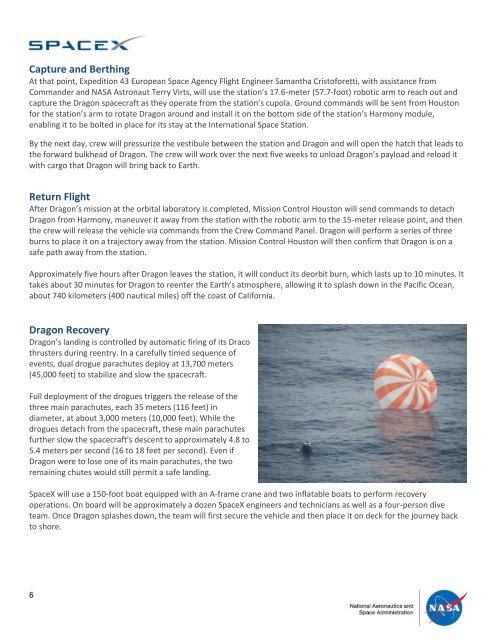spacex_nasa_crs-6_presskit
Create successful ePaper yourself
Turn your PDF publications into a flip-book with our unique Google optimized e-Paper software.
Capture and Berthing<br />
At that point, Expedition 43 European Space Agency Flight Engineer Samantha Cristoforetti, with assistance from<br />
Commander and NASA Astronaut Terry Virts, will use the station’s 17.6-meter (57.7-foot) robotic arm to reach out and<br />
capture the Dragon spacecraft as they operate from the station’s cupola. Ground commands will be sent from Houston<br />
for the station’s arm to rotate Dragon around and install it on the bottom side of the station’s Harmony module,<br />
enabling it to be bolted in place for its stay at the International Space Station.<br />
By the next day, crew will pressurize the vestibule between the station and Dragon and will open the hatch that leads to<br />
the forward bulkhead of Dragon. The crew will work over the next five weeks to unload Dragon’s payload and reload it<br />
with cargo that Dragon will bring back to Earth.<br />
Return Flight<br />
After Dragon’s mission at the orbital laboratory is completed, Mission Control Houston will send commands to detach<br />
Dragon from Harmony, maneuver it away from the station with the robotic arm to the 15-meter release point, and then<br />
the crew will release the vehicle via commands from the Crew Command Panel. Dragon will perform a series of three<br />
burns to place it on a trajectory away from the station. Mission Control Houston will then confirm that Dragon is on a<br />
safe path away from the station.<br />
Approximately five hours after Dragon leaves the station, it will conduct its deorbit burn, which lasts up to 10 minutes. It<br />
takes about 30 minutes for Dragon to reenter the Earth’s atmosphere, allowing it to splash down in the Pacific Ocean,<br />
about 740 kilometers (400 nautical miles) off the coast of California.<br />
Dragon Recovery<br />
Dragon’s landing is controlled by automatic firing of its Draco<br />
thrusters during reentry. In a carefully timed sequence of<br />
events, dual drogue parachutes deploy at 13,700 meters<br />
(45,000 feet) to stabilize and slow the spacecraft.<br />
Full deployment of the drogues triggers the release of the<br />
three main parachutes, each 35 meters (116 feet) in<br />
diameter, at about 3,000 meters (10,000 feet). While the<br />
drogues detach from the spacecraft, these main parachutes<br />
further slow the spacecraft's descent to approximately 4.8 to<br />
5.4 meters per second (16 to 18 feet per second). Even if<br />
Dragon were to lose one of its main parachutes, the two<br />
remaining chutes would still permit a safe landing.<br />
SpaceX will use a 150-foot boat equipped with an A-frame crane and two inflatable boats to perform recovery<br />
operations. On board will be approximately a dozen SpaceX engineers and technicians as well as a four-person dive<br />
team. Once Dragon splashes down, the team will first secure the vehicle and then place it on deck for the journey back<br />
to shore.<br />
6


